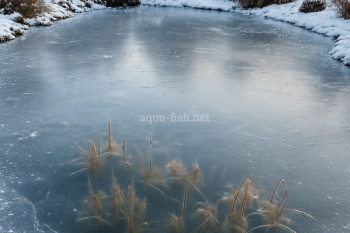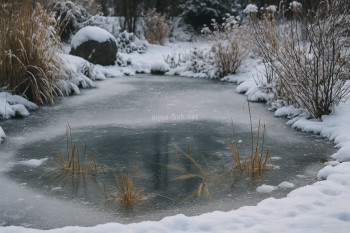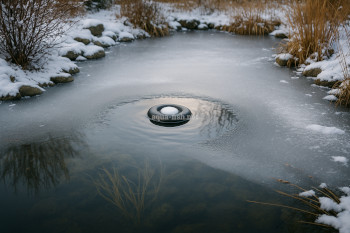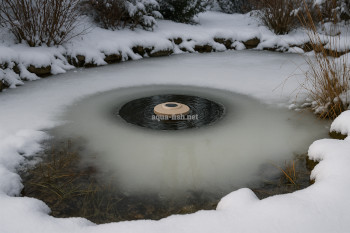Essential Guide to Pond Deicers: Winter Survival for Fish and Water Quality
Quick Links - Navigate the Guide
Brief Description
This practical guide explains everything you need to know about pond deicers — what they are, how they prevent deadly gas buildup in frozen ponds, and how to choose the right model for your needs. Whether your garden pond is small or large, floating or submersible deicers help your fish survive winter safely. We cover setup, wattage, safety tips, and FAQs for beginner and advanced pond keepers alike.
Updated: April 2025
🎯 Introduction
In the depths of winter, garden ponds in cold climates can transform into silent, frozen surfaces — but beneath that ice, trouble brews. As organic matter like fallen leaves, uneaten food, and fish waste decomposes, it releases gases such as methane and carbon dioxide. In warmer months, these gases harmlessly escape into the air. But when the pond freezes solid, the surface becomes an airtight lid — trapping toxic gases and blocking vital oxygen exchange.
Without intervention, this sealed environment can become deadly for pond fish. The buildup of waste gases and lack of oxygen can cause respiratory distress, immune suppression, or even mass die-offs among your aquatic inhabitants. This phenomenon, often misunderstood by new pond owners, is not due to cold temperatures alone — fish like koi and goldfish can handle low temps — but rather from oxygen starvation and toxic gas accumulation.
This is where a pond deicer becomes essential. Unlike a heater that warms water, a deicer maintains a small opening in the ice, allowing for continuous gas exchange. This simple but crucial function ensures that your pond remains a livable space for fish throughout winter, without disturbing the pond's natural cold-water balance.
⚙️ How Deicers Work
Pond deicers are not heaters — their purpose is not to warm the entire pond, but to maintain a single ice-free hole that allows for vital gas exchange. This small opening ensures that oxygen can enter the water and carbon dioxide and other toxic gases can escape, preventing suffocation of your fish during the winter months.
Most deicers operate using a built-in thermostat or temperature-sensitive switch. These devices automatically activate when temperatures approach freezing (around 0 °C or 32 °F) and shut off once conditions warm again, typically around 4–7 °C (39–45 °F). This energy-efficient design helps keep operating costs low while only functioning when absolutely necessary.
There are two main styles:
- Floating deicers: Remain on the surface and keep a small circular area ice-free. Ideal for most garden ponds.
- Submersible deicers: Sit just below the surface or are fully submerged and maintain an open channel through the ice. These are better for windy locations or ponds with unusual shapes.
Cold-tolerant fish can safely overwinter — as long as they can breathe. Deicers ensure oxygen can enter and harmful gases can leave, preserving the life-supporting balance under the ice.
🧊 Types of Pond Deicers
There are two main types of pond deicers, each with its own strengths depending on your pond’s size, shape, and exposure to wind:
🌊 Floating Deicers
These are the most common type. A floating deicer rests on the surface of the pond and maintains a small ice-free hole around it. Ideal for standard-sized ponds in sheltered locations.
- Pros: Easy to install and remove, highly energy-efficient with thermostat-controlled operation.
- Cons: Can be less effective in very windy areas, as heat may dissipate faster due to wind chill. May require a wind shield or shelter.
🔻 Submersible Deicers
These units are designed to operate just below the water’s surface or deeper, depending on the model. They are fully submerged and keep a vertical column of water ice-free.
- Pros: More effective in windy or exposed environments, often double as low-wattage heaters in deeper ponds.
- Cons: Require proper placement to avoid disturbing pond liner or fish habitat. Slightly more complex installation.
Some hybrid models can be used in either floating or submersible mode — check the manufacturer’s specifications to ensure compatibility with your pond setup.
Whether you choose floating or submersible, the goal remains the same: keep a hole open in the ice for gas exchange while minimizing energy usage.
📏 How to Choose the Right Deicer
Choosing the right pond deicer depends on pond size, winter severity, and energy efficiency. Picking the wrong wattage may result in frozen ponds or high electricity bills — or both.
📏 1. Pond Size
- Small ponds (under 300 gallons / ~1100 liters): 100–300 watt deicers are typically sufficient.
- Medium ponds (300–1000 gallons / ~1100–3800 liters): Use a 500–750 watt model, possibly two in extreme climates.
- Large ponds (over 1000 gallons / 3800 liters): Consider 1000–1500 watt models or multiple units for proper coverage.
❄️ 2. Local Climate
In areas with mild winters, a low-wattage floating deicer with a thermostat is often enough. For harsh climates with prolonged sub-zero temperatures, choose higher wattage and consider a submersible model.
⚡ 3. Wattage & Efficiency
- Lower wattage = lower energy cost, but may not perform in extreme cold.
- Thermostat-controlled models activate only when needed, greatly reducing energy waste.
- Some models also include wind shields or design features that prevent heat loss.
📌 Recommendations
- Choose models with thermostat or temperature sensors for automatic operation.
- Always verify that the deicer is safe for your pond liner.
- If your pond is wide and shallow, you may need more than one deicer to maintain gas exchange across the surface.
Avoid buying an oversized deicer for a small pond — this can waste electricity and potentially overheat the water near the unit. On the other hand, underpowered models may be ineffective in colder zones. Aim for the balance between sufficient power and cost-efficiency.
🔌 Installation & Safety Tips
Proper installation of your pond deicer is essential to ensure efficient operation and the safety of both fish and equipment. Avoid common mistakes and follow these key tips:
📍 Placement
- Place deicers away from strong winds — wind can blow away surface heat, reducing efficiency. If needed, use windbreaks such as plants, screens, or fencing.
- Don’t place deicers near shallow areas unless recommended by the manufacturer — they work best in stable-depth zones.
- Floating models should be placed in the middle or near areas with organic buildup to optimize gas exchange.
🔌 Cable Management
- Always use outdoor-rated extension cords and plug deicers into GFCI-protected outlets.
- Hide or bury electrical cords to protect them from pets, wildlife, and foot traffic.
- Check for damage regularly and never use frayed or cracked cables.
⚠️ What Not to Do
- Never break ice with force — hitting ice with an axe or hammer causes shock waves that may kill or injure fish.
- Do not operate deicers without water — this can lead to overheating and permanent damage.
- Don’t use deicers designed for pools or fountains in fish ponds unless specifically labeled as pond-safe.
Most importantly, install the deicer before the surface freezes. This ensures it activates automatically at the right moment and starts maintaining an open hole for gas exchange without any emergency intervention.
❓ FAQ
🥶 What if the pond is already frozen?
Do not attempt to break the ice with force — this creates shock waves that can fatally harm your fish. Instead:
- Gently place a pan of hot water on the surface to melt a hole.
- Once the opening is made, install the deicer to keep it open going forward.
Some deicers are designed to melt through thin ice on their own, but it’s always better to install them before freezing begins.
🔥 Can a deicer heat the whole pond?
No. A deicer's purpose is not to raise the water temperature but to maintain an ice-free area for gas exchange. It’s a ventilation device, not a heater. Water below the ice stays relatively stable (just above 0 °C), and fish adapted to cold can survive these temperatures — they need oxygen exchange, not tropical heat.
⚡ How is a deicer different from a pond heater?
Pond deicers:
- Keep a small hole in the ice to allow oxygen in and harmful gases out.
- Operate only when needed (usually below 0 °C), thanks to built-in thermostats.
- Use lower wattage than heaters (typically 100–1500W).
Pond heaters:
- Raise and maintain water temperature above freezing — sometimes used for tropical species in outdoor ponds.
- Use much more electricity over time and are not needed for hardy fish.
In most cases, a deicer is sufficient for keeping pond fish safe and healthy through winter.
🌿 I have a small pond — do I really need a deicer?
Yes, even small ponds need a deicer if they freeze over completely. In fact, smaller volumes of water freeze faster and more completely than larger ones, which makes gas exchange even more critical.
Choose a low-wattage deicer (e.g., 100–300W) that’s suitable for your pond size. Many models are designed specifically for ponds under 300 gallons and are energy-efficient and safe.
Remember: fish in small ponds are just as vulnerable to toxic gases and oxygen depletion as in larger ones — perhaps even more so!
🏁 Conclusion
A pond deicer may seem like a minor accessory, but in cold climates, it plays a vital role in keeping your fish alive. By maintaining a small opening in the ice, it allows toxic gases to escape and oxygen to enter — preventing suffocation and deadly winter conditions.
Whether your pond is large or small, shallow or deep, having the right type of deicer installed before freezing temperatures arrive is the key to protecting your aquatic life through winter. Choose wisely, install safely, and your fish will thank you come spring.
Don’t wait for the ice to form — be prepared, and ensure your pond stays healthy all year long.




